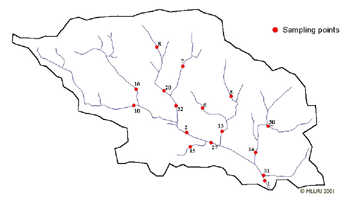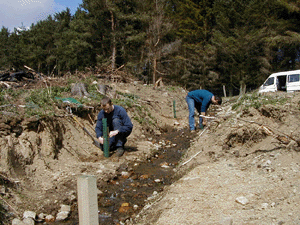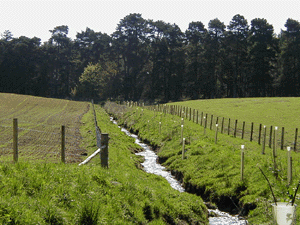The Tarland Catchment Initiative
PROGRESS
a) Monitoring and Assessment:

Sampling points across the Tarland Catchment.
The current work of the initiative consists of undertaking a baseline assessment of the spatial and temporal variability in water quality and habitats across the catchment. We have data that shows there is considerable variation in both water chemistry and the ecology of the different streams that constitute the Tarland Burn.
The implication of this is that each tributary will have a different priority for making improvements. For example, some points show high nutrient (nitrogen and phosphorus) concentrations whilst others have elevated coliform levels. These two issues will require different management and restoration programmes to reduce these pressures on the aquatic environment.
b) Implementation:

Figure 2. Tree planting with native species on the Davoch Burn clearfell site Tarland, April 2001
Within the catchment a number of sites have been selected as examples of where improvements to habitat can be made. At two sites work has already been undertaken. At the Davoch site exotic conifers that were planted right up to and in some cases in the stream channel have been removed. To improve the site there are a number of measures that need to take place. In the first instance in order to stabilise the soils on the banks the site has been planted with native hardwoods (Figure 2).
At the second site, Small Burn, the hydromorphological diversity of the stream channel has been increased from a straight uniform flow section into a series of developing pools and riffles through soft engineering of the stream banks. Further changes to increase bankside biodiversity have been undertaken through the planting of native hardwood trees. Finally, new fences have been installed to keep cattle out of the burn and minimise soil erosion and faecal inputs to the stream (Figure 3). At the same time within the fence-line greater public access has been created through the provision of a footpath.

Figure 3. Works on the Small Burn, Tarland as part of the N.E. Rivers Project: New fence, tree planting, footpath provision and soft engineering works on the stream bank
PowerPoint presentation by Simon Langan (PDF)
